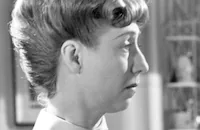Gentleman Joe Palooka
Cast & Crew
Cyril Endfield
Leon Errol
Joe Kirkwood Jr.
Guy Kibbee
Elyse Knox
Lionel Stander
Film Details
Technical Specs

Synopsis
As a guest at the Annual Sports Writers Banquet toasting his boxer, Joe Palooka, manager Knobby Walsh tells Bill Becker and Frank Neil the story behind Joe's success: Some years earlier, following Joe's knock-out victory over the previous boxing champ, Knobby tells reporters that the secret to Joe's success is "clean living." Although the reporters are initially unimpressed with Knobby's boring story, they eventually find a useful angle in it and use it for a publicity campaign centered around the "clean living" statement. Joe's personal habits, including the fact that he drinks milk and gets lots of sleep, become a nationwide story, resulting in hundreds of fan letters to the fighter. While the press exploits Joe's motto for their own purposes, Joe's wealthy Uncle Charlie tries to use Joe's good name and fame in a nefarious scheme to acquire a parcel of public land. Under the pretext of planning to use the land for the phony "Delawanna Park Project," Charlie involves Joe in his scheme by making him the official head of the project. Knobby, meanwhile, learns from Harry Mitchell, the feature editor of the Herald , that Joe is being used by Charlie for a "dirty deed." Knobby then tells Joe that in the 1920s some unscrupulous men, who made an oil grab on property belonging to the United States Government, created a scandal. As Harry explains it, Joe's uncle plans to bury oil surveys in out-of-the-way public lands and is scheming to get the land through Joe's good name. Overhearing Knobby spell out his plan, Charlie steps forward and, without denying the accusation, tries to silence Knobby and Joe by blackmailing them. Charlie warns that if the story about the land grab is broken to the press it will result in Joe and Knobby's implication in the scheme. Joe is troubled by the scheme, but nevertheless returns to the ring and continues to fight. Despondent over the situation, Joe goes into hiding, after which his sweetheart, Anne Howe, goes looking for him. As a vote on the bill that would clear the way for the land transfer goes up before the state legislature, Knobby, Joe, Harry and others are prevented by Charlie's thugs from going to the hearing to testify against the bill. Joe eventually manages to escape and arrives at the hearing in time to testify against Charlie and prevent the land from falling into the wrong hands.

Director

Cyril Endfield
Cast

Leon Errol
Joe Kirkwood Jr.

Guy Kibbee
Elyse Knox

Lionel Stander

H. B. Warner
Stanley Prager

Warren Hymer

Richard Lane
Cliff Nazarro

Fritz Feld
Sarah Padden

Louis Jean Heydt

Freddie Steele
Tommy Harmon
Roy Atwell

Ian Wolfe
Sam Mcdaniel

Eddie Gribbon

Marie Blake
Jack Roper
John Indrisano
Eddie Simms
Arthur Space
Pat Mcvey

Boyd Irwin
Wheaton Chambers
Alvin Hammer
Joe Recht
Michael Mark
Roger Daniel
William Forrest
Dorothy Neumann
Paul Scardon
Paul Turner
Danny Beck
Florence Auer
Frank Neill
Dick Fishell
Bill Becker
Shelby Payne
William Mellenthin
Jack George
Jack Shea
Russ Kaplan
Jimmy Dime
Stubby Kruger
Phil Friedman
Ray Spiker
Teddy Pavelec
Bert Lebaron
Joe Smith
Bob St. Angelo
Marshall Reed
Bruce Cameron
Robert Anderson
Robert Emmett Keane
Bill Haade
Harry Depp
Harold Brauer
Joey Ray
Ida Moore
Frances Osborne
Al Eben
Mike Lally
Phil Arnold
Crew
Bernard W. Burton
William Calihan
Mario Castegnaro
Hal E. Chester
Hal E. Chester
Glenn Cook
Ralph Dixon
Cyril Endfield
Larry Glickman
John Indrisano
Joseph I. Kane
Edward J. Kay
Tom Lambert
Lorraine Maclean
William Margulies
Dave Milton
Harry Ross
William Sickner
William H. Wilmarth

Film Details
Technical Specs

Quotes
Trivia
Notes
A Hollywood Reporter production chart for this film lists E. R. Hickson as the assistant director, however, William Calihan is listed onscreen and Hickson's participation in the film has not been confirmed. This was the second of eleven "Joe Palooka" films made by Monogram. For additional information on the series, please consult the Series Index and see the entry for Joe Palooka, Champ (below). The sparring partners and sportswriters that appeared in the film were well-known and played themselves. Actress Elyse Knox and former football star Tom "Tommy" Harmon were married in the 1940s, and their son, Mark Harmon, became a well-known television and film actor. The oil and real estate scandal featured in the film mirrors that of the famous "Teapot Dome Scandal" of the early 1920s.












